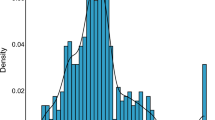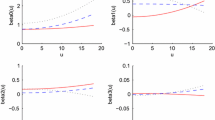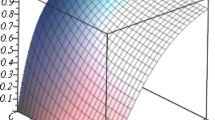Abstract
Quantile regression provides a more complete statistical analysis of the stochastic relationships among random variables. Sometimes quantile regression functions estimated at different orders can cross each other. We propose a new non-crossing quantile regression method using doubly penalized kernel machine (DPKM) which uses heteroscedastic location-scale model as basic model and estimates both location and scale functions simultaneously by kernel machines. The DPKM provides the satisfying solution to estimating non-crossing quantile regression functions when multiple quantiles for high-dimensional data are needed. We also present the model selection method that employs cross validation techniques for choosing the parameters which affect the performance of the DPKM. One real example and two synthetic examples are provided to show the usefulness of the DPKM.
Similar content being viewed by others
References
Cawley GC, Talbot NLC, Foxall RJ, Dorling SR, Mandic DP (2004) Heteroscedastic kernel ridge regression. Neurocomputing 57: 105–124
Cole TJ (1990) The LMS method for constructing normalized growth standards. Eur J Clin Nutr 44: 45–60
Härdle W (1989) Applied nonparametric regression. Cambridge University Press, Cambridge
He X (1997) Quantile curves without crossing. Am Stat 51(2): 186–192
Heagerty PJ, Pepe MS (1999) Semiparametric estimation of regression quantiles with application to standardizing weight for height and age in US children. Appl Statist 48(part 4): 533–551
Kimeldorf GS, Wahba G (1971) Some results on Tchebycheffian spline functions. J Math Anal Appl 33: 82–95
Koenker R, Bassett G (1978) Regression quantile. Econometrica 46: 33–50
Koenker R, Hallock KF (2001) Quantile regression. J Econ Perspect 40(4): 12–142
Koenker R (2005) Quantile regression. Cambridge University Press, London
Mercer J (1909) Functions of positive and negative and their connection with the theory of integral equations. Philos Trans R Soc A:415–444
Takeuchi I (2004) Non-crossing quantile regression curves by support vector and its efficient implementation. In: Proceedigns of 2004 IEEE IJCNN, vol 1, pp 401–406
Takeuchi I, Le QV, Sears TD, Smola AJ (2006) Nonparametric quantile estimation. J Mach Learn Res 7: 1231–1264
Vapnik V (1995) The nature of statistical learning theory. Springer, New York
Xiang D, Wahba G (1996) A generalized approximate cross validation for smoothin splines with non-Gaussian data. Stat Sin 6: 675–692
Yee TW (2004) Quantile regression via vector generalized additive models. Stat Med 23: 2295–2315
Yeo I, Johnson RA (2000) A new family of power transformations to improve normality or symmetry. Biometrika 87: 954–959
Yu K, Lu Z, Stander J (2003) Quantile regression: applications and current research area. Statistician 52(part 3): 331–350
Author information
Authors and Affiliations
Corresponding author
Rights and permissions
About this article
Cite this article
Shim, J., Hwang, C. & Seok, K.H. Non-crossing quantile regression via doubly penalized kernel machine. Comput Stat 24, 83–94 (2009). https://doi.org/10.1007/s00180-008-0123-y
Received:
Accepted:
Published:
Issue Date:
DOI: https://doi.org/10.1007/s00180-008-0123-y




